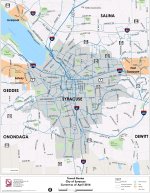Ooh, thanks for finding a source for weighted population densities. This is very useful.
Even going by
weighted population density, Boston within the MBTA service district still has a higher percentage of communties with population densities below 1,900 people per square kilometer, outpacing Los Angeles even still, in regards to ultra-low density exurbs and suburbs.
View attachment 55067
Commuter rail also already does a decent job picking up the dense downtown areas of the low density suburbs, but once you get more than 10 minutes away from the CR stop, population densities dropping below ~2,500 people per square kilometer, outside of those small, compact downtown cores, the well dries up for running meaningful 10-15 frequent bus service. Beefing up commuter rail frequencies to every 15 - 30 (or Highland D Branch/Mattapan Trolley style service), will cover most of these dense compact town centers. Here's a map of all the historical railroad ROWs overlaid on Teban's population density map, showing that the railroads already serve (or used to serve), these compact town centers.
If your outlying suburban exurb isn't near a MBTA CR stop, chances are that suburban exurb is SOL anyways. The population density of areas more than a 10 minute walk of a historical RR ROW are most likely, below 2,500 people per square kilometer, much lower than suburban Toronto's densities that sustain those frequent suburban buses that run every 10 - 15 in Toronto. (Areas in red are the streetcar suburbs). You would be hard pressed to find any large conglomerate of census blocks
outside of the streetcar suburbs, with more than 2,500 people per square kilometer, and be more than 10 minute's walk away from a historical RR ROW. (focus on areas just outside the yellow areas, NOT outside the red areas)
View attachment 55071
Man, I'm kinda both depressed and very surprised at how far the English speaking world lags in providing good transit (there's literally
NO pair of
anglophone cities that are connected by high speed rail today... Paris and Brussels don't count --- also, somehow Auckland/Melbourne/Sydney rank highly in "quality of life" - but 15 minute frequent transit only serves like 30 - 60% of the city - so 40 - 70% of those cities are also transit poor).
I've always been under the impression that a metropolitian area needs millions of residents strong, to have a large network of single digit frequencies of transit routes. It seems like only Toronto, NYC, Vancouver, and London do this right with a large network of single digit frequencies, aside from Vancouver, all of them are over 5.5 million strong. 15 minutes isn't frequency. It's still "check a timetable before going".
To live in a city of only 150,000, can a city of 150,000 even have good single digit frequency transit? Is public transit in Lowell, Lawrence, Worcester, Framingham, or Brockton, ever going to be a "legit form of transport", or are they forever relegated to being "social/welfare services", and only Boston streetcar suburbs can go car free? A city of 150,000 is typically always going to be so small that 15 minute frequencies aren't going to compete, if the distance to the edge of the city is "so short". Yet the population is also going to be tiny to justify demand for sub-10 minute frequency.
Still kinda wild and boggles my mind that almost all of the anglosphere essentially gutted small towns to become car sewers, save for a college town or two, meaning only downtown and the streetcar suburbs of big cities of 4.55 million+ (or maybe some obscure college town) can go car free.







